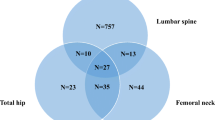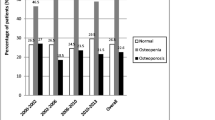Abstract
Summary
Referral patterns for bone mineral density testing by dual energy X-ray absorptiometry (DXA) scanning are seldom studied. In our study, the overall proportion of referrals from specialties remained low. This highlights the need for adequate utilisation of DXA by specialties treating subjects at risk for osteoporosis.
Purpose/objectives
The knowledge of referral patterns for DXA scanning (dual energy X-ray absorptiometry) for bone mineral density (BMD) measurement is relevant in a developing country like India. We studied the referral source and clinical and densitometric profile of patients referred for DXA scanning at a south Indian tertiary care centre.
Methods
We conducted a cross-sectional study over 3 months and included subjects referred during this period for BMD assessment (lumbar spine and femoral neck) by DXA scan. Details regarding referring departments and reasons for referral were collected. The number of patients seen in individual departments was obtained during the study period and respective proportions of patients referred were calculated.
Results
Of the 1932 subjects included in the study, we observed a definite female preponderance (90.2%), with a mean (SD) age of 51.6 (13.3) years. The greatest number of referrals came from the departments of rheumatology (37%; n = 724) and endocrinology (20%; n = 382). Overall, 36% were referred for inflammatory arthritis or systemic inflammatory disorders (n = 696) and 34% for postmenopausal state screening (n = 657). In relation to the individual outpatient strength, the departments who referred the highest proportion of their patients were rheumatology (6.8%), endocrinology (1.76%) and geriatrics (1.05%). A diagnosis of osteoporosis at any one site was made in 41% (448 of 1107) and the BMD was below the expected range for age in 37% (304 of 825) of the referrals.
Conclusion
Most referrals for DXA scanning were from rheumatology. Among the referred patients, about two fifth had osteoporosis and over one third had BMD below expected range for age. Although referrals by rheumatology were relatively higher, overall referrals from all departments remained low. This underscores the need for adequate utilisation of DXA by specialties treating subjects at risk for osteoporosis.

Similar content being viewed by others
References
Khadilkar AV, Mandlik RM (2015) Epidemiology and treatment of osteoporosis in women: an Indian perspective. Int J Womens Health 7:841–850
Paul TV, Thomas N, Seshadri MS, Oommen R, Jose A, Mahendri NV (2008) Prevalence of osteoporosis in ambulatory postmenopausal women from a semiurban region in southern India: relationship to calcium nutrition and vitamin D status. Endocr Pract Off J Am Coll Endocrinol Am Assoc Clin Endocrinol 14(6):665–671
Shetty S, Kapoor N, Naik D, Asha HS, Prabu S, Thomas N et al (2014) Osteoporosis in healthy South Indian males and the influence of life style factors and vitamin d status on bone mineral density. J Osteoporos 2014:723238
Carey JJ, Delaney MF (2017) Utility of DXA for monitoring, technical aspects of DXA BMD measurement and precision testing. Bone 104:44–53
Jeremiah MP, Unwin BK, Greenawald MH, Casiano VE (2015) Diagnosis and Management of Osteoporosis. Am Fam Physician 92(4):261–268
Shane ES, Dempster DW (2001) Bone quantification and dynamics of bone turnover by histomorphometric analysis- principles and practice of endocrinology and metabolism, Third edn. Lippincott Williams and Wilkins, Baltimore,USA, pp 541–548
Shepherd JA, Schousboe JT, Broy SB, Engelke K, Leslie WD (2015) Executive summary of the 2015 ISCD position development conference on advanced measures from DXA and QCT: fracture prediction beyond BMD. J Clin Densitom Off J Int Soc Clin Densitom 18(3):274–286
Paul TV, Selvan SA, Asha HS, Thomas N, Venkatesh K, Oommen AT et al (2015) Hypovitaminosis D and other risk factors of femoral neck fracture in South Indian postmenopausal women: a pilot study. J Clin Diagn Res:JCDR 9(6):OC19–OC22
Jha RM, Mithal A, Malhotra N, Brown EM (2010) Pilot case-control investigation of risk factors for hip fractures in the urban Indian population. BMC Musculoskelet Disord 11:49
Varthakavi PK, Joshi AS, Bhagwat NM, Chadha MD (2014) Osteoporosis treatment in India: call for action. Indian J Endocrinol Metab 18(4):441–442
Satyaraddi A, Shetty S, Kapoor N, Cherian KE, Naik D, Thomas N, Paul TV (2017) Performance of risk assessment tools for predicting osteoporosis in south Indian rural elderly men. Arch Osteoporos 12(1):35
Malhotra N, Mithal A (2008) Osteoporosis in Indians. Indian J Med Res 127(3):263–268
Shivane VK, Sarathi V, Lila AR, Bandgar T, Joshi SR, Menon PS, Shah NS (2012) Peak bone mineral density and its determinants in an Asian Indian population. J Clin Densitom Off J Int Soc Clin Densitom 15(2):152–158
Torpy AMJ, Brennan SL, Kotowicz MA, Pasco JA (2012) Reasons for referral to bone densitometry in men and women aged 20-49 years: population-based data. Arch Osteoporos 7:173–178
Health Quality Ontario (2006) Utilization of DXA bone mineral densitometry in Ontario: an evidence-based analysis. Ont Health Technol Assess Ser 6(20):1–180
Hayes BL, Curtis JR, Laster A, Saag K, Tanner SB, Liu C, Womack C, Johnson KC, Khaliq F, Carbone LD (2010) Osteoporosis care in the United States after declines in reimbursements for DXA. J Clin Densitom Off J Int Soc Clin Densitom 13(4):352–360
Cosman F, de Beur SJ, LeBoff MS, Lewiecki EM, Tanner B, Randall S, Lindsay R, National Osteoporosis Foundation (2014) Clinician’s guide to prevention and treatment of osteoporosis. Osteoporos Int J Establ Result Coop Eur Found Osteoporos Natl Osteoporos Found USA 25(10):2359–2381
Shetty S, Kapoor N, Dian Bondu J, Antonisamy B, Thomas N, Paul TV (2016) Bone turnover markers and bone mineral density in healthy mother-daughter pairs from South India. Clin Endocrinol 85(5):725–732
Kim SY, Schneeweiss S, Liu J, Solomon DH (2012) Effects of disease-modifying antirheumatic drugs on non-vertebral fracture risk in rheumatoid arthritis: a population-based cohort study. J Bone Miner Res Off J Am Soc Bone Miner Res 27(4):789–796
Yamamoto Y, Turkiewicz A, Wingstrand H, Englund M (2015) Fragility fractures in patients with rheumatoid arthritis and osteoarthritis compared with the general population. J Rheumatol 42(11):2055–2058
Dubrovsky AM, Lim MJ, Lane NE (2018) Osteoporosis in rheumatic diseases: anti-rheumatic drugs and the skeleton. Calcif Tissue Int 102(5):607–618
Tanner SB, Moore CF (2012) A review of the use of dual-energy X-ray absorptiometry (DXA) in rheumatology. Open Access Rheumatol Res Rev 4:99–107
Zerbini CAF, Clark P, Mendez-Sanchez L, Pereira RMR, Messina OD, Uña CR et al (2017) Biologic therapies and bone loss in rheumatoid arthritis. Osteoporos Int J Establ Result Coop Eur Found Osteoporos Natl Osteoporos Found USA 28(2):429–446
Dobbins AG, Brennan SL, Williams LJ, Kotowicz MA, Sarah B, Birch Y, Pasco JA (2014) Who are the older Australians referred for a bone density scan? Data from the Barwon region. Arch Osteoporos 9:196
Lewiecki EM, Laster AJ, Miller PD, Bilezikian JP (2012) More bone density testing is needed, not less. J Bone Miner Res Off J Am Soc Bone Miner Res 27(4):739–742
Amin S, Felson DT (2001) Osteoporosis in men. Rheum Dis Clin N Am 27(1):19–47
Al Attia H, Adams B (2007) Osteoporosis in men: are we referring enough for DXA and how? Clin Rheumatol 26(7):1123–1126
Gopinathan NR, Sen RK, Behera P, Aggarwal S, Khandelwal N, Sen M (2016) Awareness of osteoporosis in postmenopausal Indian women: an evaluation of osteoporosis health belief scale. J -Life Health 7(4):180–184
Pande K, Pande S, Tripathi S, Kanoi R, Thakur A, Patle S (2005) Poor knowledge about osteoporosis in learned Indian women. J Assoc Physicians India 53:433–436
Warriner AH, Outman RC, Feldstein AC, Roblin DW, Allison JJ, Curtis JR, Redden DT, Rix MM, Robinson BE, Rosales AG, Safford MM, Saag KG (2014) Effect of self-referral on bone mineral density testing and osteoporosis treatment. Med Care 52(8):743–750
Author information
Authors and Affiliations
Corresponding author
Ethics declarations
Conflicts of interest
None.
Rights and permissions
About this article
Cite this article
Binu, A.J., Cherian, K.E., Kapoor, N. et al. Referral pattern for DXA scanning in a tertiary care centre from southern India. Arch Osteoporos 13, 133 (2018). https://doi.org/10.1007/s11657-018-0548-z
Received:
Accepted:
Published:
DOI: https://doi.org/10.1007/s11657-018-0548-z




